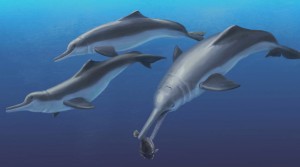A new species of extinct dolphin closely related to modern Amazonian ‘river dolphins’, but which dwelled in ancient oceans, is helping to solve the mystery of how and when dolphins adapted for life away from the sea.
Freshwater dolphins are endangered, largely due to human activity. In modern ecosystems, only five or six species remain, and among these, the Yangtze ‘river dolphin’ was declared ‘functionally extinct’ in 2006.
These animals are truly remarkable, and show what scientists have interpreted as adaptations for helping to navigate the murky waters of the winding rivers they inhabit: broad, paddle-shaped flippers, and long narrow snouts – much longer than their modern, sea-dwelling cousins – and flexible necks for catching rapidly darting prey.

An artist’s recreation of Isthminia panamensis feeding on a flatfish. Many features of this new species appear similar to today’s ocean dolphins, yet the new fossil species is more closely related to the living Amazon River dolphin. Image: Julia Molnar / Smithsonian Institution
Scientists from the Smithsonian discovered a new genus and species of extinct ‘river dolphin’, hailing from the Caribbean Coast of Panama 6 million years ago during a time known as the Miocene. Based on a skull and parts of the right flipper, they estimate it could grow to more than 9 feet in length, just slightly larger than its modern relatives. The new animal is named Isthminia panamensis, as a dedication to the people of the Republic of Panama, and the many scientists who’ve studied the biology and geology of the region.
The unearthing of Isthminia shows that the ancestors of modern river dolphins had a much broader geographic range. There are only two known living species of ‘river dolphin’ in South America, but their fossil relatives stretch across the South Pacific and North Atlantic oceans. Close comparison of Isthminia to both fossil and living dolphins showed that its closest living relative is the living Amazon river dolphin, which despite its name is known from several other South American river systems.

Scientists collected the fossils of Isthminia panamensis from the Caribbean coast of Panama. The fossil was encased in a white plaster jacket and recovered as the tide rushed in. Image: Aaron O’Dea / Smithsonian Institution
The new discovery shows that after 6 million years ago, ‘river dolphins’ transitioned from the salty seas to inland rivers. Isthminia was found in rocks that formed under the Caribbean Sea, in a time before the Panama Isthmus, a strip of land lying between the Atlantic and the Pacific oceans, closed. At some point after it went extinct Isthminia’s ancestors underwent the evolutionary step towards occupying the rivers of the Amazon basin.
“We discovered this new fossil in marine rocks, and many of the features of its skull and jaws point to it having been a marine inhabitant, like modern oceanic dolphins,” said the study’s lead author Nicholas Pyenson. For example, it had a long, tooth-filled snout, perfectly adapted for fishing out at sea, but a feature retained in its modern ancestors for hunting in rivers. The bones of the shoulder blade are also unusual, with the scapula bone taking on the shape of an “ice cream scoop”, according to the study!
The sea-land transition might have been caused by increasing sea levels towards the end of the Miocene, flooding continents and forcing marine animals to adapt to new environments. “Isthminia now gives us a clear boundary in geologic time for understanding when this lineage invaded Amazonia”, says Pyenson.
This shows a reversal from the usual story we know about for whales and dolphins, in that they took to the seas from a land-dwelling ancestor many millions of years before. These kinds of sea-to-land transitions are unusual but important occurrences in the history of animals, and we have to look to fossils to understand why they happened. In Amazonia, river dolphins now join the ranks of manatees, turtles, and stingrays in making this tactical decision.
With ever more restricted distributions, and under increasing conservation threat, the discovery of Isthminia might help spur action into preserving what little remains of these amazing animals.
The new study is reported in the open access journal PeerJ, and a 3D scan of the fragile fossil has been created by the Smithsonian’s Digitization Program Office, so you can even print out your very own extinct dolphin skull (also available here)!
A version of this article was published at: http://www.earthtouchnews.com/discoveries/fossils/this-ancient-species-discovery-finally-explains-where-river-dolphins-come-from

Pingback: Morsels For The Mind – 18/09/2015 | Sandora RSS Feed Aggregator Portal